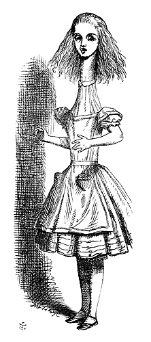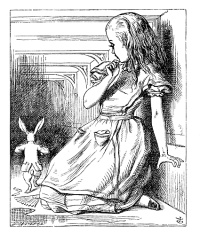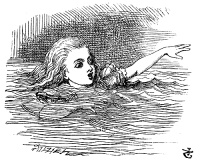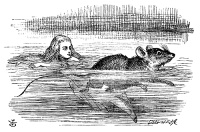The Pool of Tears
Studies in Alice II, by Marc Edmund Jones
This lesson considers the second chapter of Alice in Wonderland and the second great principle of wisdom in the Philosophy of Concepts as revealed through the adventures of Alice is that consciousness is a tangible substance. This is a point of almost primary importance in any philosophical study for the reason that unless consciousness itself is made subject to analysis and mastery, man is not only limited in knowledge to the outer sphere of visible fact but by acceptance of this limitation he is made hardly more than a pawn on some cosmic chessboard and there left subject to the whims and in bondage to the caprice of a divine player. The substantial nature of consciousness is the keynote in any realization of the fundamental nature of character. It opens the whole field of psychology to definite and personal mastery. Reality as found in all things is seen to be inherent in the consciousness rather than in the outer makeup and situation. Sooner or later every factor in life and manifestation must be traced back to consciousness. The terms mind and idea express respectively the conceptions of activity and form in consciousness, and consciousness will be seen to be the very substance of divinity. Philosophers cannot conceive a universe devoid of consciousness whether spiritual or mechanical in nature whereas they can annihilate every other factor involved in visible or invisible manifestation. When substantial idea or intelligence is given to consciousness itself, then it becomes possible to resolve the whole universe and every item of its content to order and understanding.
 The basis of
a real or spiritual psychology is found in the fact that man must create
the substance of his own consciousness and that unless he does this his
consciousness is merely borrowed from his associates or environment and
as a result he is in constant bondage to these factors. In prior work of
the Philosophy of Concepts this principle was brought out in the catch
phrase of moodiness is next to godliness and in the present lesson it might
be modified as tearfulness is next to godliness. Long before Lewis Carroll
wrote this chapter it was well recognized that man is forced to swim through
his own tears in life or that he creates the substance of his own sensation.
Tearfulness is merely the symbol of all revelation of feeling or the creation
of the substance of consciousness, since tears are mostly associated with
strength of sensation whether pain or grief on the one hand or delight
and joy on the other. The swimming in the tears is no more than the substance
of self in awareness on the surface of consciousness-stuff.
The basis of
a real or spiritual psychology is found in the fact that man must create
the substance of his own consciousness and that unless he does this his
consciousness is merely borrowed from his associates or environment and
as a result he is in constant bondage to these factors. In prior work of
the Philosophy of Concepts this principle was brought out in the catch
phrase of moodiness is next to godliness and in the present lesson it might
be modified as tearfulness is next to godliness. Long before Lewis Carroll
wrote this chapter it was well recognized that man is forced to swim through
his own tears in life or that he creates the substance of his own sensation.
Tearfulness is merely the symbol of all revelation of feeling or the creation
of the substance of consciousness, since tears are mostly associated with
strength of sensation whether pain or grief on the one hand or delight
and joy on the other. The swimming in the tears is no more than the substance
of self in awareness on the surface of consciousness-stuff.

Feeling is the tangible creation of awareness, and it is a necessity of his existence that man possess feeling and by some means make it manifest. In the symbolism of Alice in Wonderland this point is brought out exquisitely in the falling of the animals into the pool of tears. The fall in all cosmic symbolism is descent into manifestation, and in this chapter the sudden appearance of these animals is interesting not only in their nature and type but in the detail of their arrival almost out of nowhere. Animals are in fact the specialized and outer general traits or characteristics of man. This is taught in the Bible when Adam brings the animals into manifest or outer being by naming them and it is well recognized by humanity generally in the common use of animals to typify traits by saying that a man is a hog, a dog, and so on. The tears of Alice make possible the appearance to her in tangible shape of her own traits and characteristics when she descends into the consciousness she has created as she fans herself.
 The achievement
of imagination in the chapter, or the second great scientific anticipation,
is the demonstration of the fundamental equilibrium of nature. Everything
returns to its own state or retreats eventually within its own being or
consciousness. Change lies in an alteration of the combinations of factors
in being and not in any fact of inner reality. The indestructibility of
matter and of force as demonstrated by science needs only to have added
to it the concept of the indestructibility in form that is demonstrated
but not recognized by science. Savants know that nature proceeds through
a definite and invariable order of stages in all its production of higher
organisms but fail to see in this the necessary third factor in a complete
indestructibility concept. Professor Millikan came close to this greatest
of all scientific truths in his dramatic promulgation of a creation still
in process. He approached the problem of an apparent disintegration of
the universe and recognized the indestructibility of matter and force by
showing the existence of invisible cosmic rays at work repairing or replacing
the disintegration. The form of the universe thus was seen to be indestructible
or as recreated as fast as disintegrated and was perhaps for the first
time allowed to support the other two phenomena logically.
The achievement
of imagination in the chapter, or the second great scientific anticipation,
is the demonstration of the fundamental equilibrium of nature. Everything
returns to its own state or retreats eventually within its own being or
consciousness. Change lies in an alteration of the combinations of factors
in being and not in any fact of inner reality. The indestructibility of
matter and of force as demonstrated by science needs only to have added
to it the concept of the indestructibility in form that is demonstrated
but not recognized by science. Savants know that nature proceeds through
a definite and invariable order of stages in all its production of higher
organisms but fail to see in this the necessary third factor in a complete
indestructibility concept. Professor Millikan came close to this greatest
of all scientific truths in his dramatic promulgation of a creation still
in process. He approached the problem of an apparent disintegration of
the universe and recognized the indestructibility of matter and force by
showing the existence of invisible cosmic rays at work repairing or replacing
the disintegration. The form of the universe thus was seen to be indestructible
or as recreated as fast as disintegrated and was perhaps for the first
time allowed to support the other two phenomena logically.
As all goes back to consciousness so the foundation of creation is idea. When the processes of apparent change are completed, everything involved returns to its original state. Man recognizes this in his mental and creative processes, as in the necessity of starting from fixed foundations of understanding, and science at last sees this same striving for equilibrium throughout nature. Therefore in the book the constant replacement of the key on the table is interesting as is the constant closing of the door to the little garden. The symbolism of the table is doubly interesting as the glass suggests consciousness and the three legs suggests activity, substance and form. In life man by his own efforts or consciousness must hold all things in manifestation. It is the realization of this that makes juggling a fascinating feat and often humorous and stimulating to consciousness.
The law of applied psychology or the second big idea for the solution of personal problems is brought out here in the technique of accuracy. The parody of Rev. Isaac Watt's "How Doth the Little Busy Bee" is the first of the book's nonsense verses, and the merit of the crocodile conceit lies in the general familiarity, at least in 1862, of the stanzas thus twisted. Here is the reminiscent strain of Tin Pan Alley, long the center of song writing and publishing in New York City. As in the writing of popular music, so in all extensions of consciousness and the unfamiliar must at least suggest the familiar. Accuracy depends on memory, memory depends on association and association in mind depends on the essence of facts or their inner and real relationships. Knowledge is inherent in its essence not in its facts, and accuracy in facts is dependent on ability to hold to the essence. Familiarity is thus the easiest basis of accuracy but it is the least scientific since it remains in bondage to time and accident. Fun and nonsense bring out the essence because humor is consciousness-stimulating perversion of seriousness, and the ability to take outer things lightly with real humor as opposed to the respect-killing counterfeit is the most outstanding mark of genuine mastership. The student must learn to DO SOMETHING ELSE in any moment of baffled consciousness. Alice turned to her own confusion and reestablished her equilibrium. The useless something else has its value in permitting consciousness to function unhampered by the limiting details of the confused situation, and consciousness has but to function by and of itself to restore itself.

Sabian.org





